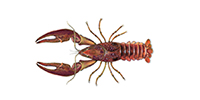Thank you for visiting the Seafood Selector. EDF is planning a new approach to providing information to consumers about good seafood choices. Please come back soon for updates.
Crawfish

Crawfish
Recommended servings per month
| Contaminant | Men | Women | Kids 6-12 | Kids 0-5 | |
|---|---|---|---|---|---|
| Crawfish (U.S., farmed) | Mercury | 4+ | 4+ | 4+ | 4+ |
| Crawfish (U.S., wild) | Mercury | 4+ | 4+ | 4+ | 4+ |
| Crawfish (imported) | Unknown | 4 | 4 | 4 | 4 |
Eco details:
Although some U.S. crawfish are captured in the wild, most are farmed in rice fields or ponds. Crawfish eat natural vegetation, so no feed or chemicals are needed.
Crawfish are also farmed in China, where they are considered an invasive species and escapes have disrupted aquatic ecosystems.




